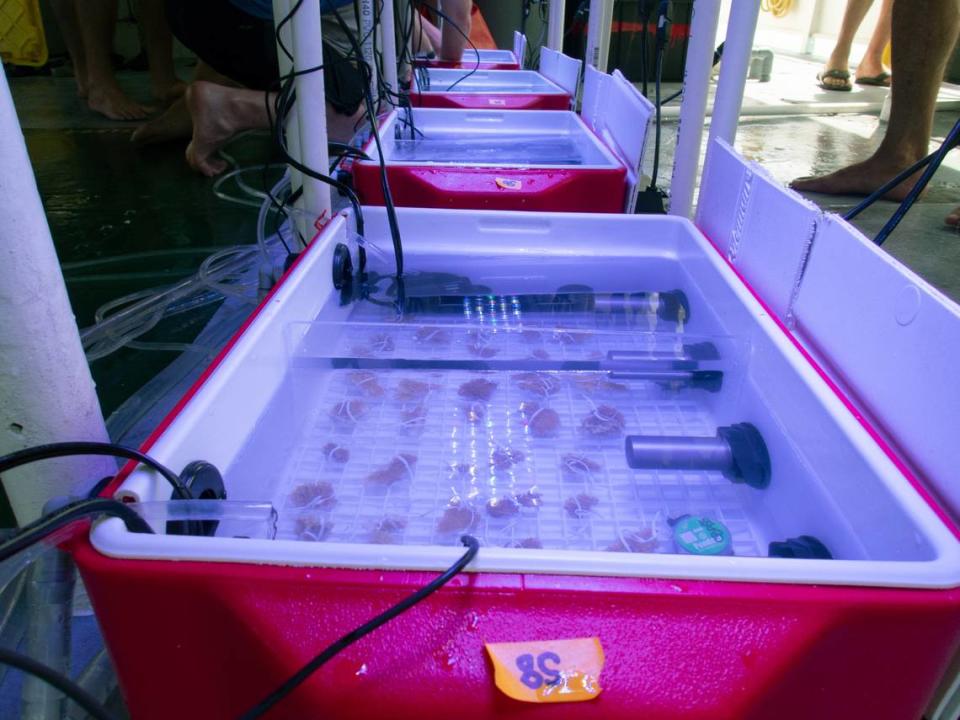In a warming ocean, some corals are winners. UM study has insights on heat tolerance
For coral scientists trying to save the world’s reefs from climate change, the big existential question is: how to help these vital ecosystems withstand the heat of a warming ocean and resist a damaging effect called bleaching.
In a new study led by the Shedd Aquarium and the University of Miami Rosenstiel School of Marine and Atmospheric Science, scientists set out to understand why some coral colonies and even individual corals are better at tolerating heat than others. Rising heat is increasing the frequency of bleaching, when corals are hurt by changes in conditions like temperature, light or pollution, and expel their symbiotic algae, causing them to go completely white.
They looked at 229 colonies in six locations where coral nurseries with the threatened staghorn coral have been built on the Florida coast, from Broward to the Keys. Together, these nurseries make up the most extensive single-species coral restoration program in the world. The study was published this week in the Proceedings of the Royal Society B: Biological Sciences.
Using portable stress tanks built from coolers, scientists exposed corals to different temperatures and measured how much heat stress each coral could withstand before showing signs of bleaching.
Insights from this census of heat tolerance will help organizations working to restore reefs with heat-resistant corals and boost their chances of survival. While this type of study has been done with colonies in the wild, this is the first time a census was conducted in corals grown in nurseries for restoration purposes.
“Knowing which corals are more tolerant to heat will save us a lot of time in restoration projects. With these tests we can tell which corals are winners and good candidates for breeding and for other restoration efforts,” said Andrew Baker, professor in the Department of Marine Biology and Ecology at the UM Rosenstiel School, and a co-author of the study. “And it’s a fast test, we can get results in a matter of days.”

During two research expeditions on a Shedd research vessel in August and October last year, scientists collected coral fragments and put them in tanks built from eight regular 24-can coolers. They were equipped with an aquarium heater and a chiller, and seawater was circulated within each cooler with pumps.
The coral fragments were exposed to increases in temperature starting from a baseline of 30 degrees Celsius (86 Fahrenheit) to as hot as 38 degrees. The results allowed scientists to identify colonies and individual corals that were more resilient. Variations sometimes occurred within nurseries, among corals that were near each other, Baker said.
While this study was performed in Florida, Baker said there is growing interest among scientists and managers in surveying heat tolerance in other coral populations around the world. The research provides a blueprint for other efforts to identify heat-tolerant corals and gives a significant boost to restoration programs trying to stem the sharp decline of reefs due to climate change.
Scientists from Australia to the Keys are racing to restore reefs as climate change, more frequent bleaching events, increased coastal development, pollution and overfishing are killing corals at an alarming rate.

In Florida, warmer temperatures cause nutrient-rich waters to produce more algae, which can suffocate corals. Dredging has affected colonies, and increased boat and ship traffic around the Florida reef tract has also taken a heavy toll on corals. Over the past few years, a mysterious disease that erupted about five years ago off Virginia Key began spreading very fast down the coast. In June, it reached the Dry Tortugas, where just last year scientists were collecting healthy corals to add to coral labs around the country to create a gene bank for restoration efforts.
Nova Southeastern University, Mote Marine Laboratory, the Florida Fish and Wildlife Conservation Commission, Reef Renewal and the Coral Restoration Foundation participated in the study.
A coral sex milestone: Lab-grown and replanted corals to spawn in the Florida Keys

 Yahoo Movies
Yahoo Movies 
